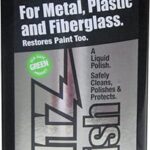A flawless car exterior speaks volumes about your vehicle’s upkeep and your personal style. However, the realities of driving often lead to dents and dings, diminishing your car’s appeal, resale value, and potentially leading to rust. Understanding how to repair car dents is essential for every car owner.
Whether it’s a minor ding or a more noticeable dent, various repair options are available. For smaller imperfections and bumper grazes, DIY methods can often suffice. Larger dents might necessitate the expertise of paintless dent repair (PDR) technicians or a visit to a professional auto body shop for a showroom finish.
This guide will walk you through everything you need to know about car dent repair, covering DIY techniques, professional services, cost considerations, and how to make informed decisions to restore your car’s pristine condition.
Understanding Car Dents
Car dents come in various forms, each requiring different repair approaches. Knowing the type of dent you’re dealing with is the first step in effective repair.
| Type | Description | Must Know Info About Removal |
|---|---|---|
| Ding | A small, shallow area of damage | Often simple DIY fixes |
| Round Dent | A circular indentation | May be “popped” back out |
| Sharp Dent | Small, deep, and concentrated divots | More challenging to repair |
| Crease Dent | Long, linear dent with potential paint damage | Professional repair often recommended |
| Serious Dents | Large or multiple dents, potentially with structural damage | May indicate structural issues impacting safety |
Dents can also be categorized by their cause and location on the vehicle. Common causes include:
- Hail and Road Debris: Small dents from environmental factors like hail stones or kicked-up road debris.
- Parking Lot Incidents: Shopping carts, opening doors into adjacent vehicles or walls causing dings and dents.
- Collisions and Impacts: Larger dents resulting from minor accidents, falling tree branches, or more significant impacts.
Furthermore, consider the material of the dented area. Body panels are typically metal (steel or aluminum), while bumpers are usually plastic. Repair methods will differ based on the material.
Why Repair Dents Quickly?
Addressing car dents promptly is not just about aesthetics; it’s crucial for several practical and safety reasons. While DIY repairs can be budget-friendly, and professional repairs are a bigger investment, delaying repairs can lead to more significant issues down the line.
- Preserving Appearance: Dents detract from your car’s visual appeal. Repairing them restores its sleek look and pride of ownership.
- Preventing Rust and Corrosion: Damage to the paint from dents exposes the metal underneath, making it vulnerable to moisture, rust, and paint flaking, especially in regions with harsh weather.
- Avoiding Structural Damage: Larger dents, particularly crease dents from substantial impacts, can sometimes conceal underlying structural damage, compromising the vehicle’s integrity and safety in future collisions.
- Maintaining Fuel Efficiency: While seemingly minor, multiple dents can negatively impact your car’s aerodynamics, leading to increased drag and reduced fuel economy over time.
Prompt dent repair is a proactive approach that protects your car’s value, longevity, and your safety.
DIY Car Dent Repair Methods
For minor dents and dings, you can often achieve satisfactory results with DIY methods at home. Here are some common techniques:
Repairing Plastic Bumper Dents with Heat
Plastic bumpers are generally more flexible and can often be manipulated back into shape with heat.
- Heat Application: Use a hairdryer to gently warm the dented area until the plastic becomes warm and pliable to the touch.
- Cooling and Shaping: For small dents, quickly spray compressed air ($20 or less at Walmart) over the heated area. The rapid cooling can cause the plastic to contract and pop back into its original shape.
- Dent Puller for Larger Dents: If compressed air isn’t sufficient, or for larger dents, use a suction cup dent puller ($20 or less at Amazon). Attach the puller to the center of the dent and apply firm, steady pressure to pull the dent outwards.
- Smoothing Imperfections: After pulling the dent, minor surface irregularities might appear. Gently smooth these out with your hands or the dent puller.
Repairing Metal Dents with a Dent Repair Kit
For metal dents, specialized dent repair kits ($40-99 at Amazon) offer a more targeted approach to pulling out the dent. These kits typically include a bridge puller and adhesive tabs.
- Heating (Optional): For smaller, shallower dents, heating might not be necessary. For deeper dents, pre-heating the area with a hairdryer can make the metal more workable.
- Suction Puller (Initial Step): Use a suction cup puller to reduce the depth of the dent. The goal is to make the dent less pronounced, not necessarily to remove it completely at this stage.
- Cleaning the Area: Thoroughly clean the dented metal surface with a microfiber towel to remove any dirt or wax, ensuring proper adhesion for the next steps.
- Applying Adhesive Head: Apply the special glue from the repair kit to the head (bolt-like piece). Attach the head to the deepest point of the dent, pressing firmly.
- Curing the Adhesive: Allow the glue to dry completely according to the kit’s instructions (usually 4-8 minutes) to ensure a strong bond.
- Using the Bridge Puller: Attach the bridge puller over the glued head. Turn the dial on the bridge puller slowly to gradually pull the metal outwards. Monitor the dent’s shape and stop when the metal is level with the surrounding panel.
- Removing Head and Adhesive: Detach the bridge puller. Use a hairdryer to gently heat the glue securing the head. Once softened, carefully remove the head and wipe away any remaining adhesive residue.
- Paint Touch-Up (If Needed): If the dent repair process has caused minor paint damage, use a paint repair kit ($45-$65 at Dr. ColorChip) to touch up the area. Clean the area, apply primer, and then carefully apply thin layers of touch-up paint until the damage is concealed.
Using Body Filler for Deeper Imperfections
For dents that are difficult to remove entirely or leave behind surface imperfections, body filler (like Bondo® – $13+ at AutoZone) can be used to create a smooth, even surface before repainting.
- Cleaning the Dent Area: Clean the dent and surrounding area thoroughly with soap and water, then dry it with a microfiber cloth.
- Sanding: Use 80-grit sandpaper to remove paint from the dent and about 2-5 inches around it. This creates a surface that body filler can properly adhere to.
- Minimize Dent Depth: Use DIY dent removal techniques (heat, puller) to reduce the dent’s depth as much as possible before applying filler.
- Applying Body Filler: Mix the body filler according to the product instructions. Apply the filler firmly into the dent, using a putty knife or applicator. Ensure the filler is level with the surrounding body panel, slightly overfilling is better as it can be sanded down. Let it dry for 15-20 minutes as recommended.
- Initial Sanding: Once dry, use 80-grit sandpaper to shape and smooth the filler, removing excess material and roughly contouring it to the body panel’s shape.
- Fine Sanding: Switch to 180-grit sandpaper to refine the shape and smooth out any rough edges left by the 80-grit paper.
- Glazing Putty Application: Apply a thin layer of glazing and spot putty ($11+ at Amazon) over the filled area and slightly beyond. This helps to fill in pinholes and minor imperfections in the body filler.
- Final Sanding: After the glaze dries, sand with 180-grit sandpaper, followed by 320-grit sandpaper to eliminate any visible scratches and create a feather-edge for paint adhesion.
- Priming and Painting: Use a paint repair kit to prime and paint the repaired area, blending the new paint seamlessly with the surrounding car finish.
Professional Car Dent Repair Options
When DIY methods are insufficient, or for those seeking a flawless, guaranteed repair, professional services offer expertise and specialized tools.
Paintless Dent Repair (PDR)
Paintless Dent Repair (PDR) is a highly skilled technique for removing dents without affecting the car’s original paint finish. PDR technicians use specialized tools to gently massage and manipulate the metal from behind the panel, effectively “pushing” the dent out.
PDR is ideal for:
- Dents without paint damage.
- Small to medium-sized dents.
- Maintaining the vehicle’s original factory finish.
PDR offers several advantages:
- Cost-Effective: Generally less expensive than traditional body shop repairs, especially for smaller dents.
- Faster Turnaround: Repairs are often completed in a few hours, sometimes even on the same day.
- Convenience: Mobile PDR services are often available, where technicians come to your location.
PDR Pricing Guide:
| Dent Size | Average Cost |
|---|---|
| Small, Light | $50 – $100 |
| Medium | $75 – $300 |
| Large | $300 – $500 |
Auto Body Shop Repair
For larger, more complex dents, dents with paint damage, or dents suspected of causing structural issues, an auto body shop provides comprehensive repair services.
Auto body shops offer:
- Traditional Dent Repair: Techniques including hammering, body filler, and repainting.
- Frame Repair: Addressing structural damage from severe impacts.
- Color Matching and Repainting: Ensuring a seamless paint finish after dent repair.
Auto body shop repair is necessary for:
- Large or deep dents.
- Dents with paint damage requiring refinishing.
- Crease dents and dents in hard-to-reach areas.
- Suspected structural damage.
However, auto body shop repairs are generally more expensive and take longer than PDR or DIY methods. For significant damage, it’s wise to get estimates from multiple shops to compare pricing and service offerings. In cases of extensive damage, consider whether panel replacement might be more cost-effective than extensive dent repair.
Cost of Car Dent Repair
The cost to repair car dents varies significantly based on the repair method, dent size and complexity, and location.
- DIY Repair: Typically under $100 for materials like dent repair kits, body filler, and sandpaper. DIY is the most affordable option for minor dents but requires time and effort.
- Paintless Dent Repair (PDR): Ranges from $50 to $500 depending on dent size and location. PDR offers a balance of professional quality and cost-effectiveness for many types of dents.
- Auto Body Shop: Can range from several hundred to thousands of dollars, potentially exceeding $2,000 for significant damage requiring extensive bodywork and repainting.
It’s always advisable to get quotes for your specific dent from both PDR technicians and auto body shops to make an informed decision based on your budget and desired outcome.
Financing Car Dent Repair
Unexpected car repairs can strain your budget. The Synchrony Car Care™ Credit Card can help manage these expenses, offering promotional financing options for car repairs at participating locations. This can make professional dent repair more accessible when needed.
Conclusion
Repairing car dents is an essential aspect of vehicle maintenance, preserving your car’s appearance, value, and structural integrity. Whether you choose the DIY route for minor imperfections or opt for professional services like PDR or auto body shops for more significant damage, addressing dents promptly prevents further complications and maintains your vehicle in optimal condition. Assess the type and severity of the dent, consider your budget and desired outcome, and take action to restore your car’s smooth, dent-free finish.


